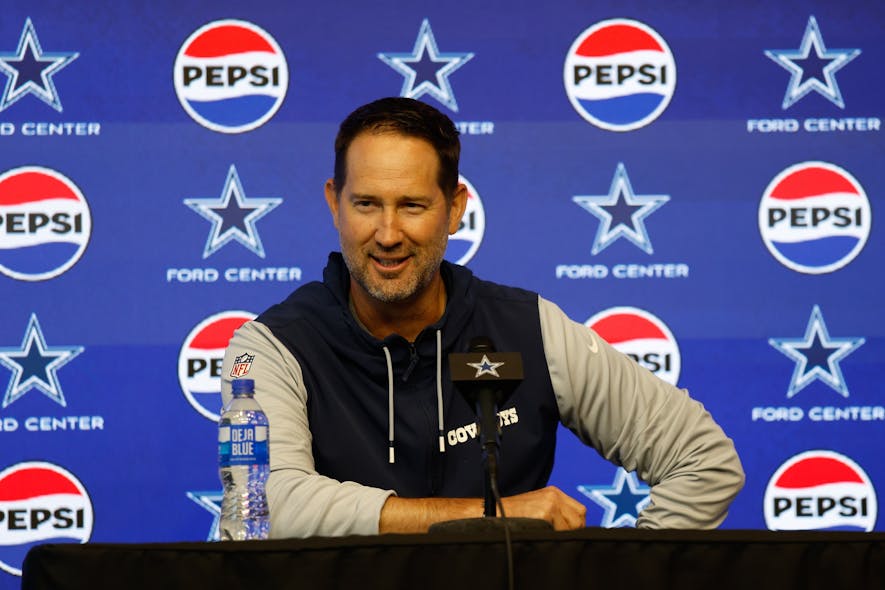RELATED: Check out an in-depth analysis of Detroit's new offensive coordinator
Brian Schottenheimer takes over as the Cowboys' offensive play-caller in 2025, following Mike McCarthy's departure after his contract expired. Schottenheimer's career run/pass split marks a clear philosophical shift from how Dallas has operated in recent years. Under Kellen Moore, the Cowboys passed nearly 58% of the time. Even after McCarthy took over play-calling, the trend didn't change much, with pass rates of 58.3% in 2023 and 61.1% in 2024.
Schottenheimer wants to implement a more balanced approach, one designed to keep defenses honest and open up play-action shots downfield to CeeDee Lamb and George Pickens. It's a sound plan on paper. But a young, unproven offensive line, a backfield lacking reliable production, and a defense that cratered last year could all force him off script. And history has shown that when Schottenheimer is forced away from balance, his offenses rarely hold up.
Fantasy Takeaways at a Glance
- QB Dak Prescott is likely to see a drop in volume. Schottenheimer prefers balance and ball control. Prescott remains efficient, but a 10 to 15% drop in attempts would hurt his weekly ceiling. Based on his career averages — 5.1% touchdown rate, 2.0% interception rate, 7.7 yards per attempt, and a 66.8% completion rate — a drop to 540 attempts would yield around 4,158 yards and 28 touchdowns. A drop to 500 attempts could pull him down to 3,850 yards and 26 scores. That would likely put his ceiling in the QB10 to QB12 range, with a floor closer to a league-average QB2: efficient but capped by reduced volume and limited rushing upside.
- WR CeeDee Lamb remains a WR1, but is more volume-sensitive than in past years. We're assuming a 26% target rate, consistent with his elite usage the past two seasons, but there's far less wiggle room for him to match his first-round ADP if the team shifts from 600-plus pass attempts to something closer to 500 to 540. That would put Lamb in the 130-target range, which still makes him the centerpiece of the passing game but puts real pressure on him to stay hyper-efficient to return top-tier fantasy value.
- WR George Pickens has big-play ability, but he's the most likely casualty of a scaled-back passing attack. Our baseline assumption is a juicy 20% target rate, but even that may only get him into the WR3 mix if Dallas throws 500 to 540 times. He's more boom-or-bust than his ADP suggests, and if the run game works and game scripts lean positive, Pickens may vanish for stretches in a lower-volume system.
- TE Jake Ferguson finds his ceiling capped in a run-heavy offense. While he may still carve out red zone opportunities and see some play-action targets, he's best viewed as a low-end, matchup-based starter or, more realistically, a bye-week or injury replacement for your TE1.
- RB Javonte Williams has a path to a major workload, but it's fair to ask whether he has the efficiency and durability to handle a lead role behind one of the league's worst offensive lines.
- RB Jaydon Blue is generating rookie buzz, but the reality is his draft capital makes him no more likely to have a significant role than fellow rookie Phil Mafah or veteran Miles Sanders.
Who Is Brian Schottenheimer?
Coaching History (Source: Pro-Football-Reference)
| Year | Age | Level | Employer | Role |
|---|---|---|---|---|
| 1997 | 24 | NFL | St. Louis Rams | Assistant |
| 1998 | 25 | NFL | Kansas City Chiefs | Assistant |
| 1999 | 26 | College (FBS) | Syracuse | Wide Receivers |
| 2000 | 27 | College (FBS) | USC | Tight Ends |
| 2001 | 28 | NFL | Washington Redskins | Quarterbacks |
| 2002 | 29 | NFL | San Diego Chargers | Quarterbacks |
| 2003 | 30 | NFL | San Diego Chargers | Quarterbacks |
| 2004 | 31 | NFL | San Diego Chargers | Quarterbacks |
| 2005 | 32 | NFL | San Diego Chargers | Quarterbacks |
| 2006 | 33 | NFL | New York Jets | Offensive Coordinator |
| 2007 | 34 | NFL | New York Jets | Offensive Coordinator |
| 2008 | 35 | NFL | New York Jets | Offensive Coordinator |
| 2009 | 36 | NFL | New York Jets | Offensive Coordinator |
| 2010 | 37 | NFL | New York Jets | Offensive Coordinator |
| 2011 | 38 | NFL | New York Jets | Offensive Coordinator |
| 2012 | 39 | NFL | St. Louis Rams | Offensive Coordinator |
| 2013 | 40 | NFL | St. Louis Rams | Offensive Coordinator |
| 2014 | 41 | NFL | St. Louis Rams | Offensive Coordinator |
| 2015 | 42 | College (FBS) | Georgia | Offensive Coordinator |
| 2016 | 43 | NFL | Indianapolis Colts | Quarterbacks |
| 2017 | 44 | NFL | Indianapolis Colts | Quarterbacks |
| 2018 | 45 | NFL | Seattle Seahawks | Offensive Coordinator |
| 2019 | 46 | NFL | Seattle Seahawks | Offensive Coordinator |
| 2020 | 47 | NFL | Seattle Seahawks | Offensive Coordinator |
| 2021 | 48 | NFL | Jacksonville Jaguars | Quarterbacks/PGC |
| 2022 | 49 | NFL | Dallas Cowboys | Consultant |
| 2023 | 50 | NFL | Dallas Cowboys | Offensive Coordinator |
| 2024 | 51 | NFL | Dallas Cowboys | Offensive Coordinator |
| 2025 | 52 | NFL | Dallas Cowboys | Head Coach |
Schottenheimer has a long NFL résumé that spans over two decades. He began his coaching career in the late 1990s, holding early roles with the Rams and Chiefs as a position coach. His first offensive coordinator job came with the New York Jets in 2006, where he served under Eric Mangini and later Rex Ryan. He remained with the Jets through 2011, helping guide them to consecutive AFC Championship Game appearances.
He then moved on to the St. Louis Rams (2012-2014), where he worked with Sam Bradford and a rotating cast of quarterbacks during a rebuilding stretch. After a stint at the University of Georgia as offensive coordinator in 2015, Schottenheimer returned to the NFL as quarterbacks coach for the Colts (2016) and then the Seahawks (2018-2020), where he worked with Russell Wilson during some of the team's most productive offensive seasons. His final stop before Dallas was a brief stint in Jacksonville in 2021, where he served as passing game coordinator during Trevor Lawrence's turbulent rookie year.
In Dallas, Schottenheimer joined the staff in 2023 as offensive coordinator but did not call plays under Mike McCarthy. His style is rooted in old-school principles: run the ball, control tempo, use play-action, and avoid turnovers. But he has shown occasional flexibility, notably with the early "Let Russ Cook" phase in Seattle.
His best work has come when paired with a strong run game and capable defense. In New York and Seattle, those conditions led to playoff runs. When the run game faltered or he was forced to go pass-heavy, the results were mixed to poor.
A Long and Winding Play-Calling Career
Over 12 full seasons as a primary NFL play-caller, plus a 4-game stint in Jacksonville in 2021, Brian Schottenheimer's offenses have averaged a 46.1% run rate and 53.9% pass rate, demonstrating a preference for balance that leans slightly toward the pass. His most run-heavy year came in 2009 with the Jets (58.9% run), while his most pass-oriented season was 2020 in Seattle (59.8% pass).
Schottenheimer's play-calling reputation has been shaped by his context: results have fluctuated based on the quality of his offensive line, quarterback, and ability to sustain a credible rushing attack. He's led playoff-caliber units when these elements aligned, but his offenses have struggled when forced away from balance or when the supporting cast failed to execute his vision.
When It Clearly Worked
| Year | Team | PPG (Rank) | Run% | Pass% | Outcome |
|---|---|---|---|---|---|
| 2008 | Jets | 25.3 (9th) | 43.0% | 57.0% | 9-7 record, late-season collapse |
| 2018 | Seahawks | 26.8 (6th) | 52.8% | 47.2% | Playoff berth |
| 2019 | Seahawks | 25.3 (9th) | 46.0% | 54.0% | Playoff berth |
These seasons were marked by strong run games, positive game scripts, and a quarterback in Russell Wilson who operated efficiently within Schottenheimer's system. This includes the 2008 Jets offense, which ranked in the top 10 in scoring before collapsing late under Brett Favre's turnover issues.
When It Kind of Worked
| Year | Team | PPG (Rank) | Run% | Pass% | Outcome |
|---|---|---|---|---|---|
| 2006 | Jets | 19.8 (18th) | 48.5% | 51.5% | 10-6 record, playoff berth |
| 2009 | Jets | 21.8 (17th) | 58.9% | 41.1% | AFC title game |
| 2010 | Jets | 22.9 (13th) | 49.1% | 50.9% | AFC title game |
| 2020 | Seahawks | 28.7 (8th) | 40.2% | 59.8% | 12-4 record, offense collapsed late |
These teams leaned on elite defenses and strong ground games to support their quarterbacks. The 2020 Seahawks opened with fireworks, averaging 34 points per game over the first eight weeks, but once defenses adjusted and forced more predictable dropbacks, the offense plummeted (23 points per game). That second-half collapse contributed directly to Schottenheimer's firing.
When It Didn't Work


